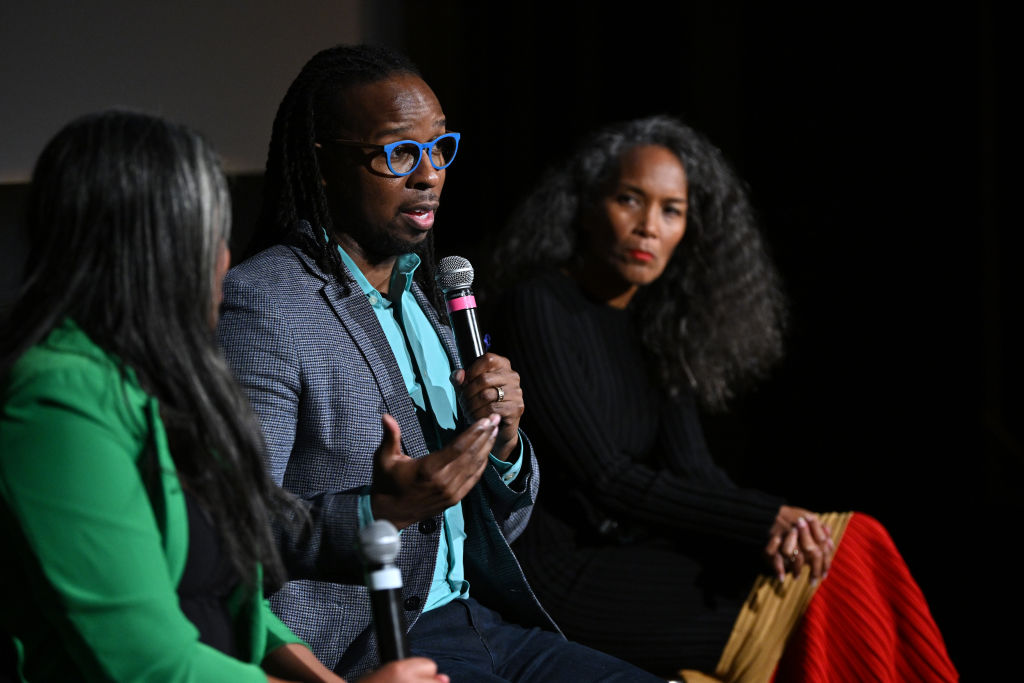The advertising industry is the unacknowledged legislator of wokeness.
Multi-culti Reckoning

The Democrats’ appeal to racial resentment is wearing thin.
The explosion of support for Hamas’s assault on human decency could well turn out to be the high-water mark of the progressive Left. The authoritarian multicultural ideology generated on campuses and transmitted dutifully by the established media has reached its apex and may now begin to descend.
The signs are tentative but some are unmistakable. Corporate and university Diversity, Equity, and Inclusion (DEI) departments are being slashed, and increasingly seen as both burdensome and discriminatory toward whites, Jews, and Asians. One-third of DEI professionals lost their jobs in 2022. Brands that posted Pride month messages in 2022, such as Lego and Miller Lite, have abandoned such posturing. Even the Navy deleted Pride-related messaging from Instagram and Twitter.
Perhaps more significant may be the rebellion of donors to the leading universities, prime movers of the ideology that drives everything from the DEI establishment. Money is the mother’s milk of politics and universities and foundations alike. The overt hostility toward Israel on campuses, and the resulting feeling of threat among Jewish students, makes Jewish and non-Jewish donors wonder where their money is going.
Even liberal Jews, such as Berkeley Law School dean Erwin Chemerinsky, have been shocked by the rise of racialized and antisemitic politics at prestigious institutions. A possible loss of Jewish voters matters little at the presidential level but could prove relevant in Pennsylvania and Michigan. Unlike their French, Canadian, and British co-religionists, they may function as a rearguard in reining in the far Left.
But the biggest loss may be financial, as well as intellectual. As William Domhoff pointed out in his 1972 book Fat Cats and Democrats, wealthy Jews have been, since the New Deal, major leading donors of the Democratic Party. Jews provide roughly half of all donations, and comprise many of Biden’s top contributors.
This shift, however, extends well beyond Jews, as many long-time Democrats recoil from the party’s embrace of an ideology—propounded by influential leftist intellectuals such as Frantz Fanon, Herbert Marcuse, and Michel Foucault—that justifies criminal violence if committed by an oppressed identity group, a policy calculated to spark ever more ethnic turmoil. This perspective divides the world into “oppressors” and “oppressed,” and demands that society restructure itself in favor of the traditional out-groups. This includes an open assault on the idea of merit, essentially undermining the very basis of liberal society, and demeaning the potential of upward mobility due to racial factors.
This “anti-racist” ideology draws support from cultural arbiters as well as corporate human resources departments and left-wing non-profits like Ford, the Rockefeller Brothers Foundation, the Open Society, and others from the billionaire class, but are widely rejected by the vast majority of working- and middle-class minorities. This is evident in the rejection of politically toxic stances like “open borders,” which has support from the elites, including from doctrinaire libertarians, but is less well-regard by the working and middle classes who have to cope with competition from indigent undocumented people for housing, public services, and medical care, as is evident in places like New York and Chicago.
The border turns out to be one place where the prevailing “anti-racist” ideology backfires even among the ethnic groups most tied to the new migrants. With illegal crossings at record levels, the maintenance of a porous border is not winning support among Latinos, even among legal immigrants. After all, they and other working-class Americans have to live with the consequences; they feel abandoned by policies that keep borders open and totally unmanaged. The shift is seen in the predominately Latino, historically Democratic stronghold of South Texas, which has borne the brunt of Biden’s renunciation of the American border.
Blacks and other minorities do not favor defunding the police or the abolition of prisons, even as these policies are pushed in their name. Beyond abandoning the streets to criminals, which impacts the poor most, the Progressive cultural agenda does not prioritize the butter-and-eggs issues that concern minority working families. Latinos have certainly not taken to the term “Latinx” that the academic/media duopoly has applied to them in the interest of gender politics; barely four percent of Latinos use the term.
According to one recent survey, immigrants are twice as conservative in their social views than the general public and widely reject the identity politics central to the current Democratic belief system. Immigrants also tend to be both more religious than whites; new sex education standards, which include some graphic representations of carnal acts, have provoked opposition from the Latino, Asian, African American, and Muslim communities. Latinos are more likely to favor restrictions on abortion than other ethnic groups by a ten point margin, notes Pew.
Overall, as Ruy Texiera and John Judis point out in their important new book, Where Have All the Democrats Gone?, the radical multicultural agenda is alienating much of the party’s traditional base. Indeed, recent polling cited by Teixiera sees widescale erosion of support among Democratic-presumed constituencies—working class, Latino, youth, women, and some African Americans. Even Donald Trump—a man labeled “racist” in the mainstream media, a term also applied to his voters—won a significantly larger Latino vote, particularly in Florida and Texas, in 2020 and is doing even better in his current election drive. He also shows signs of building on his gains with African Americans, in large part due to the impact of inflation and crime.
And then there is the reaction among non-Hispanic whites, who still constitute some 57 percent of the population. (Many Hispanics also identify as white, to complicate matters.) To a large extent, the progressive Left regards this population as somewhat toxic and hopelessly racist. Rather than seek commonalities with the majority, they tend to see white nationalism not as a movement of the lunatic fringe but as what defines the country; as one Washington Post writer put it, “because White people are likely to be the majority of voters for at least two more decades, America is in trouble.”
Oddly, a movement obsessed with the identity of non-whites, gays, and trans people seeks to obliterate the experiences of other ethnic groups. In California, the new social studies curriculum categorizes all whites, no matter wherever their origins, as enjoying “white privilege.” Groups like Jews, the Irish, and other European immigrants did not suffer discrimination, but instead indulged their “white privilege,” like the descendants of Boston Brahmins or southern planters.
The most intriguing and determinative factor may prove the attitudes of young people. Many, particularly whites from outside the elite, are not likely to embrace policies that place themselves, or their offspring, at a permanent disadvantage. Crazy pro-Hamas demonstrators may be young, but, at least among white youth, particularly males, the trend is definitely to the Right, with Trump basically even with Biden among young voters. This parallels developments in Europe, including Germany, Italy, Finland, Sweden, and most recently the Netherlands, particularly regarding immigration.
The problem for the Democrats, as Texeira and Judis suggest, is that while many Americans may be willing to support traditional Democratic policies, for example, on extending health care coverage or restoring our dilapidated infrastructure, they are not about to support an ideology that is focused on turning the country into an inverted version of Hitler’s racial state. The whole idea that people should be judged on their degree of victimhood—gender, race, national origin—strikes most as manifestly unfair for such matters as college admissions.
At the same time, the radical racially-obsessed multicultural approach does not reflect America’s demographic reality. The country is becoming multi-racial and more diverse on its own. In 2020, 840,000 green card holders became citizens, the most in a decade, with all of the ten leading countries home to “people of color.” Over ten percent of the American electorate was born elsewhere, the highest share in a half century.
Perhaps even more importantly, we continue to see massive-ground level integration—what my friend Sergio Muñoz calls “the multiculturalism of the streets.” The multicultural Left may favor segregating students, but on the ground level there is ever greater mingling. This is epitomized by the growing acceptance of interracial marriage; according to Gallup, approval for such unions has risen from four percent in 1958 and 50 percent in the mid-nineties to 94 percent today. Today the fastest growing race in America is mixed; one in ten babies born in the U.S. have one white and one non-white parent, and 12 percent of blacks are now immigrants from Africa, the Caribbean, and elsewhere.
The image of America as an “apartheid state” like the former South Africa is simply absurd. Most minorities no longer live in isolated rural enclaves or dense urban ghettos. In the 53 metropolitan areas with more than 1,000,000 residents, more than three-quarters of black and Hispanic residents live in racially and ethnically diverse suburbs, ranging from 20 percent to 60 percent non-white. Minorities are also moving away from big cities like New York, San Francisco, Los Angeles, Seattle, and Portland (whose city council is demanding reparations for the very people who are exiting the inner city) while their numbers are rising in many red state metros like Houston, Dallas, Phoenix, Salt Lake City, Boise, and Las Vegas.
So rather than flocking to places where the racial agenda is strongest, minorities are headed in the opposition direction, and for good reasons. Adjusting for cost of living, African Americans and Latinos do worst in California, New York, Massachusetts, and Illinois. African Americans in Los Angeles, for example, do slightly worse than their counterparts in ultra-deep red Mississippi.
As they move to suburbs, cities, and small towns of the heartland, minorities are embracing the idea—and living it—that America does not despise them but offers them hope. Crowing about “the end of white America” might be popular in ethnic studies departments but does not necessarily translate into a better life for most minorities. Indeed, Glenn Loury suggests, the whole racialist agenda serves to rob minorities of their “agency,” their ability to succeed through their own efforts. In addition, DEI is not a jobs program for struggling working-class people; its prime beneficiaries, predictably enough, are among the usually more affluent and educated minorities who find their careers enhanced in a regime that seeks to all but marginalize whites and limit the rise of inconvenient minorities, notably Asians.
What working-class minorities need is not more Maoist “struggle sessions” but pro-family, pro-growth policies that address the needs of the broad working class. Corporate mea culpas about racism, paid solidarity with Black Lives Matter, and expanding minority corporate board membership may blunt criticism, but it won’t help most poorer minorities. Blacks and other minorities, suggests former Citibank Chairman Richard Parsons, will only feel better when they “feel it in their pockets.”
Rather than follow the oppression mantra, Democrats, notes Ruy Teixiera, would do better addressing the everyday concerns of minorities who already make up over 40 percent of the nation’s working class and will constitute the majority by 2032. But this requires a shift in Democratic messaging away from race, climate, and abortion to issues like inflation, rising crime, poor schools, and the economic fallout from draconian green policies. If not, it may be the Right, so traditionally tied to more nativist impulses, that may gain more than expected from America’s increasingly diverse population.
The American Mind presents a range of perspectives. Views are writers’ own and do not necessarily represent those of The Claremont Institute.
The American Mind is a publication of the Claremont Institute, a non-profit 501(c)(3) organization, dedicated to restoring the principles of the American Founding to their rightful, preeminent authority in our national life. Interested in supporting our work? Gifts to the Claremont Institute are tax-deductible.
The affirmative action regime took a major, if not fatal, blow.
The California Reparations Task Force is trying its best to skirt a landmark Supreme Court ruling.
The woke lie that racism has gotten worse needs to be called out.
In the calculus of blame, whites are the new Jews.
The advance of the Revolution from King to Gay.






